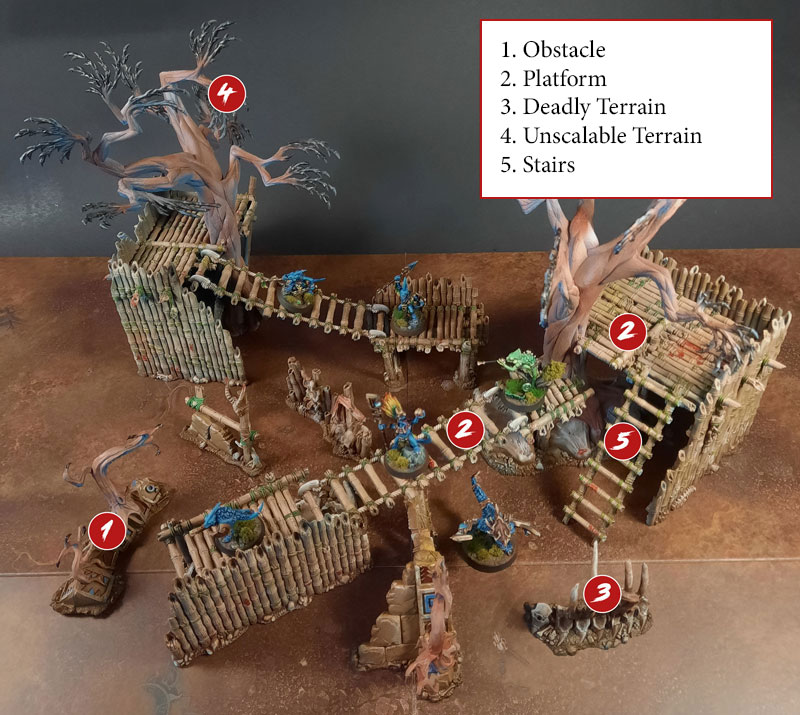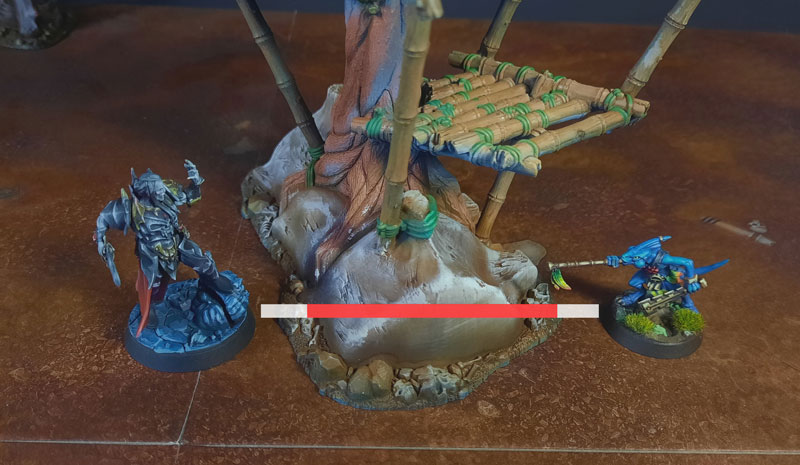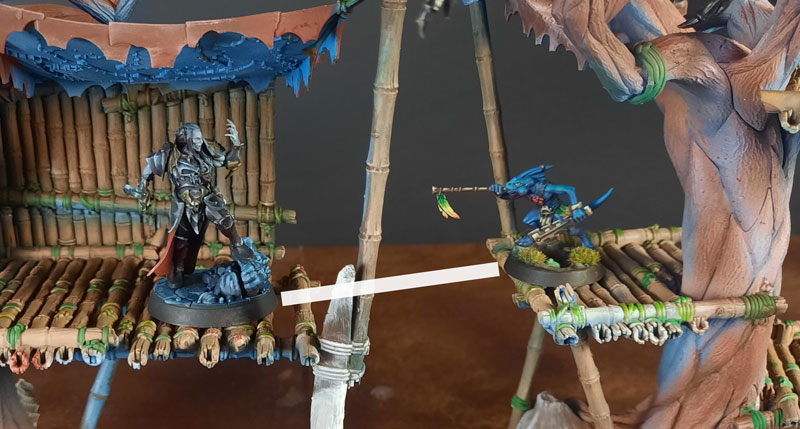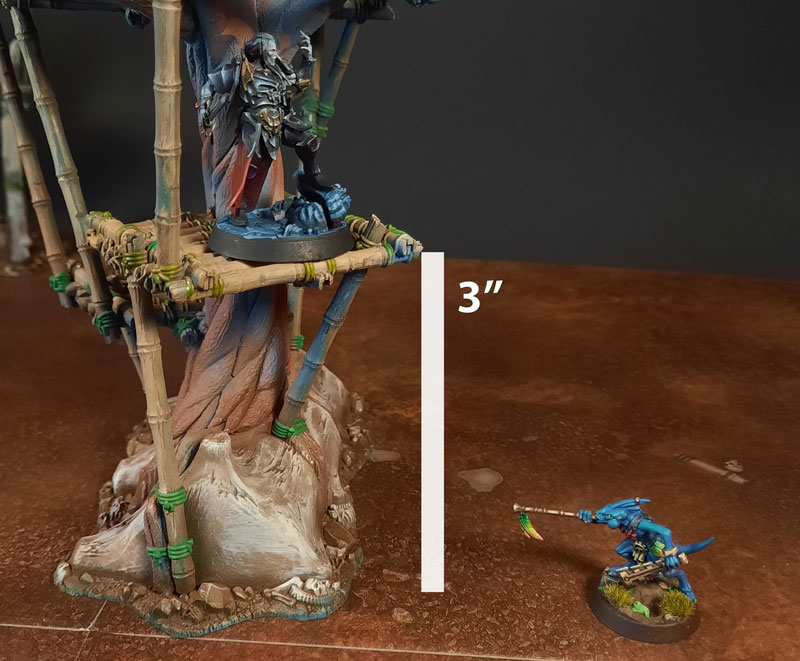Terrain
In every Warcry battle, there will be 1 or more terrain features. Fighters can interact with terrain features in numerous ways when making move actions. This section introduces the other interactions fighters can have with terrain features, and also describes the different types of terrain features.
It is important to note that a terrain feature can be made up of multiple types of terrain as detailed in this section. For example, in the case of a ruined building, its walls would be obstacles, the upper floors would be platforms, it might have a door built into it, and any debris around it would be low terrain.

Obstacles
The most common type of terrain is an obstacle. An obstacle is any part of a terrain feature that prevents a fighter from moving horizontally and that extends vertically 1" or more from the battlefield floor or the platform upon which it is placed. A wall is an example of an obstacle.
Low Terrain
Any part of a terrain feature that extends vertically less than 1" from the battlefield floor or the platform upon which it is placed is known as low terrain. When a fighter moves normally, they can move without penalty over low terrain. This means that any vertical distance moved while moving over such a part of a terrain feature does not count against the total number of inches fighters can move in that move action. In addition, low terrain is treated as part of the battlefield floor or the platform upon which it is placed.
Platforms
Another common type of terrain feature is a platform. A platform is a horizontally flat surface on a terrain feature with a surface area larger than 1" by 1".
Falling Off Terrain
When a fighter within ½" of the edge of an open platform (i.e. an edge that is not enclosed by an obstacle, such as a wall) is targeted by an attack action, their controlling player must take a falling test for them after the attack action has been resolved.
To take a falling test for a fighter, roll a dice. On a 1, the fighter falls. This rule does not affect fighters with the Fly runemark ().
Deadly Terrain
Spiked walls and fences, including those made from jutting rib bones, are deadly terrain. Deadly terrain is treated as an obstacle, but when a fighter begins to climb it, allocate D6 damage points to that fighter first. In addition, when a fighter is placed after falling, if they are placed within 1" of any deadly terrain, allocate D6 damage points to that fighter.
Unscalable Terrain
Another type of terrain is unscalable terrain. The following parts of terrain features are unscalable terrain:
- Statues
- Braziers
- Tree branches and foliage
- Fountains
Unscalable terrain is treated as an obstacle with the following exception: fighters cannot climb or move on unscalable terrain. If a fighter ends an action on unscalable terrain, they first suffer impact damage and then they fall.
Stairs And Ladders
Stairs and ladders are treated as obstacles, with the following exceptions:
- Fighters that finish their activation climbing stairs or ladders do not fall and can remain part way up (if it is not possible to physically place the fighter in their current location, make a note of where they are).
- When an attack action targets an enemy fighter that has ended their activation climbing stairs or ladders, the target fighter must take a falling test after the attack action has been resolved.
- Fighters with the Mount runemark () can climb stairs.
Archways And Doors
A terrain feature may have archways or doors.
As part of a move action, if a fighter comes into contact with an archway or a door, that fighter can move normally through it even if the model or its base is too large to physically fit through (or it is blocked completely, as in the case of a closed door). This is an exception to the rule that states that a fighter cannot move through any part of a terrain feature.
To move through an archway or a door, first measure the distance in a straight line through the horizontal centre of the archway or door. If the fighter has sufficient movement to pass through the archway or door and be placed on the other side, they can move through it.
When fighters move through archways and doors, all other movement rules must still be followed (for example, they cannot move through another fighter).
Restrictions
Fighters with any of the following runemarks cannot move through archways:
- Monster ()
- Mount ()
Fighters with any of the following runemarks cannot move through closed doors:
- Monster ()
- Mount ()
- Beast ()
If you have any unique terrain features in your collection, discuss with your opponent before the battle begins what parts of the terrain feature are obstacles, platforms, unscalable, etc.
Cover
Obstacles and platforms can provide protection to fighters from attacks. When a fighter is targeted by an attack action, players must first determine if they are in cover.
If a fighter is in cover, add 1 to their Toughness characteristic for the duration of that attack action.
Obstacles
To determine if a target fighter is in cover due to any obstacles, draw an imaginary line between the closest points on each fighter's base (for rules purposes, the line is considered to be 1mm wide). If the line passes through an obstacle, the target fighter is in cover.
If the fighters are more than 1" away from each other, do not count parts of obstacles within ½" of the fighter making the attack action (this represents fighters that have weapons with a longer range being able to aim around corners, through gaps in nearby terrain, and so on).
Platforms
When a fighter on a platform is targeted by an attack action, they are in cover if the fighter making the attack action is 2" or more vertically below the target fighter.

These two fighters are in cover from each other. This is because a straight line drawn between the closest parts of their bases will pass through the skull, which is an obstacle.

It is important to note the line drawn must pass through an obstacle and not simply over it. These two fighters are not in cover from each other because while a straight line drawn between the closest parts of their bases passes over an obstacle, it does not pass through an obstacle.

In this example, the fighter on the platform is in cover from the fighter on the battlefield floor because they are more than 2" vertically higher.